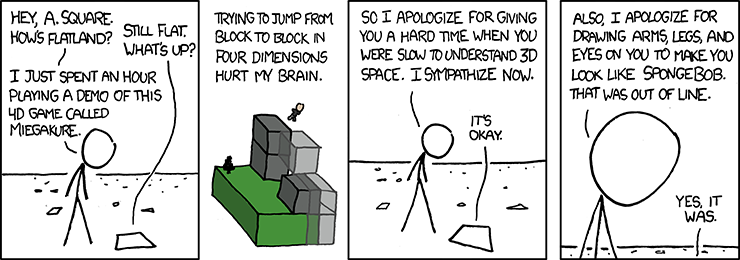This has been an interesting month for new theories being advanced about how our universe fits in with the omniverse. Regular readers of this blog will recall that "omniverse" is the term I've come to prefer for referring to the set of all of the underlying information, all of the multiverses, all universes, and all parallel universe versions of those universes, as a single concept. The terms "multiverse" or "multiverse landscape" also can refer to this same idea, but not as decisively: there are actually many different "flavors" of multiverse being proposed from various camps. As noted in the wikipedia article on "multiverse", physicist Max Tegmark prefers to use the term "ultimate ensemble": omniverse is another way of thinking about this same over-arching idea.
On April 8th, Paul Howard Frampton submitted a paper to arxiv.org which, in his words, presents "a simple, and hopefully convincing, discussion of a solution to the dark energy problem, which arises because the visible universe is well approximated by a black hole." Here is a link to his announcement, and here is a link to the pdf of his paper. Interestingly, his paper contends that there is no need for gravitons to exist, an idea we've explored several times lately in this blog. For instance, the poll question we were running here at the tenth dimension blog last month ended up split absolutely evenly: 50% agreed that gravitons will never be observed because they don't exist, and 50% disagreed.
Last month, in Holograms and Quanta, and Strength of Gravity, Speed of Light, we looked at a new theory from Dr. Erik Verlinde of the University of Amsterdam, which suggested the same idea: just as there are no "liquidons" imparting the quality of liquidity to a collection of H2O molecules, Dr. Verlinde suggests that gravity is also something that arises naturally from our position with the omniverse.
 On April 12, the journal Physics Letters B published a new paper by Indiana University physicist Nikodem Poplawski. The Science Daily article about this new theory included the graphic at left, which is a depiction of an Einstein-Rosen bridge, a theoretical construct which could be used to connect one universe to another. Dr. Poplawski's theory appears to be related to this concept. In the National Geographic article about his new theory, author Ker Than described it like this:
On April 12, the journal Physics Letters B published a new paper by Indiana University physicist Nikodem Poplawski. The Science Daily article about this new theory included the graphic at left, which is a depiction of an Einstein-Rosen bridge, a theoretical construct which could be used to connect one universe to another. Dr. Poplawski's theory appears to be related to this concept. In the National Geographic article about his new theory, author Ker Than described it like this:
Like part of a cosmic Russian doll, our universe may be nested inside a black hole that is itself part of a larger universe.
In turn, all the black holes found so far in our universe—from the microscopic to the supermassive—may be doorways into alternate realities.
According to a mind-bending new theory, a black hole is actually a tunnel between universes—a type of wormhole. The matter the black hole attracts doesn’t collapse into a single point, as has been predicted, but rather gushes out a “white hole” at the other end of the black one, the theory goes.
 Isn't it funny to see a concept that science fiction fans have been reading and watching stories about for decades being discussed as if it's a new idea? In comments at my blog and discussions at the tenth dimension forum, I've mentioned a great science fiction novel by John Cramer called "Einstein's Bridge", which is about what happens when a particle accelerator opens up a connection to another universe.
Isn't it funny to see a concept that science fiction fans have been reading and watching stories about for decades being discussed as if it's a new idea? In comments at my blog and discussions at the tenth dimension forum, I've mentioned a great science fiction novel by John Cramer called "Einstein's Bridge", which is about what happens when a particle accelerator opens up a connection to another universe.The difference here, of course, is that Dr. Poplawski is proposing new equations that help to explain how this process could actually occur.
Which takes us back to the beginning of this entry: if science is starting to understand how all of these different universes could be connected together, all equally real, all existing simultaneously, and if the distinction between past present and future is meaningless (as Einstein liked to say), then that web of all connections is a way of thinking about the Omniverse. We'll continue looking at this idea of how all these universes fit together next time with an entry called Our Universe as a Dodecahedron.
Enjoy the journey,
Rob Bryanton










